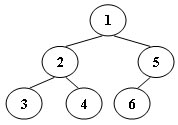我觉得这道题真的是树的递归的应用的超级好的例题,把二叉树的遍历的递归性的举一反三的能力考察的淋漓尽致。
从输入的push pop可以看出来就是给出了前序和中序,输出是后序遍历:
前序就是每次push时候的输出:1 2 3 4 5 6; 中序就根据pop的顺序:3 2 4 1 6 5; 再确定一下整棵树的根节点就是 push 的第一棵树 1;然后把先序的遍历值储存在preorder[30]中,把中序的遍历值储存在inorder[30]中,然后再调用makeMyTree函数。
递归调用makeMyTree函数的话,那么总的思路就是:递归左子树 + 递归右子树 + 输入根节点。是不是很像后序输出?我们的任务就是找到树的根节点。
我一直觉得其实每一个节点都是一个子树,比如叶节点,两个子树都是NULL,那么这个节点就是这个子树的根,这和用堆栈进行后续遍历是同样的道理, (如果把叶节点看成一棵树的话,第一次访问:入栈; 第二次访问,左节点为NULL,返回; 第三次访问,右节点为NULL,返回。而且实际上得归也是这么做的),在这里就用length == 0来做判断.
03-树3 Tree Traversals Again(25 分)
An inorder binary tree traversal can be implemented in a non-recursive way with a stack. For example, suppose that when a 6-node binary tree (with the keys numbered from 1 to 6) is traversed, the stack operations are: push(1); push(2); push(3); pop(); pop(); push(4); pop(); pop(); push(5); push(6); pop(); pop(). Then a unique binary tree (shown in Figure 1) can be generated from this sequence of operations. Your task is to give the postorder traversal sequence of this tree.

Figure 1
Input Specification:
Each input file contains one test case. For each case, the first line contains a positive integer N (≤30) which is the total number of nodes in a tree (and hence the nodes are numbered from 1 to N). Then 2N lines follow, each describes a stack operation in the format: "Push X" where X is the index of the node being pushed onto the stack; or "Pop" meaning to pop one node from the stack.
Output Specification:
For each test case, print the postorder traversal sequence of the corresponding tree in one line. A solution is guaranteed to exist. All the numbers must be separated by exactly one space, and there must be no extra space at the end of the line.
Sample Input:
6
Push 1
Push 2
Push 3
Pop
Pop
Push 4
Pop
Pop
Push 5
Push 6
Pop
Pop
Sample Output:
3 4 2 6 5 1先看关于指针参数传递的一些测试
#include <stdio.h>
void test1(int a[]);
void test2(int *a);
int main(int argc, const char * argv[]) {
int a[5] = {1,2,3,4,5};
test1(a);
test2(a);
}
void test1(int a[]){
printf("%p\n",a); //address 0x7fff5fbff6b0
printf("%p\n",a+1); //address 0x7fff5fbff6b4 地址加了4位
printf("%d\n",a[0]); //number of a[0]
}
void test2(int *a){
printf("%p\n",a); //address 0x7fff5fbff6b0
printf("%p\n",a+1); //address 0x7fff5fbff6b4
printf("%d\n",*a); //number of a[0] 相当于解义
printf("%d\n",a[0]); //number of a[0]
}然后这道题的代码:
#include <stdio.h>
int root; /*建这个变量是为了奇葩的输出格式*/
void makeMyTree(int *preorder, int *inorder, int length);
int main(int argc, const char * argv[]) {
char st[4];/*store push or pop*/
int length,tmpindex = 0,preindex = 0,inindex = 0;
int preorder[30];
int inorder[30];
int tmp[30];
scanf("%d",&length);
/* 初始化数组 */
for(int i = 0; i < 30; i++){
preorder[i] = 0;
inorder[i] = 0;
tmp[i] = 0;
}
/* 读入前序和中序的顺序 */
for (int i = 0; i < 2*length; i++) {
scanf("%s",&st);
if(st[1] == 'u'){/* 如果输入的是push */
scanf("%d",&preorder[preindex]);
tmp[tmpindex] = preorder[preindex];
preindex ++;
tmpindex ++;
}else{ /* 如果输入的是pop */
inorder[inindex++] = tmp[--tmpindex];
}
}
root = preorder[0]; /* 确定根节点*/
makeMyTree(preorder, inorder,length);
return 0;
}
/* preorder[] is the address */
void makeMyTree(int *preorder, int *inorder, int length){
if(length == 0) return;
int number = *preorder; /*储存当前子树的根节点*/
int rootindex;
for(rootindex = 0; rootindex < length; rootindex ++){
if(inorder[rootindex] == *preorder)
break;
}
makeMyTree(preorder + 1, inorder, rootindex); /*递归左子树*/
makeMyTree(preorder + rootindex +1, inorder + rootindex + 1, length-(rootindex+1));/*递归右子树*/
if(number != root)
printf("%d ",number);
else
printf("%d",number);
return;
}





















 3779
3779

 被折叠的 条评论
为什么被折叠?
被折叠的 条评论
为什么被折叠?








